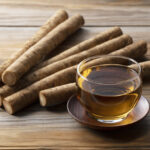Could THIS plant compound help fight nonalcoholic fatty liver disease?
 (NaturalHealth365) Most people don’t think of burdock root (if they’ve heard of it at all) as a particularly well-known or popular vegetable. Yet, anyone who enjoys Asian cuisine has probably experienced its mild, nutty flavor and crunch. Botanically known as Arctium lappaa, burdock root is not only a nutritious staple of Asian cuisine but also a valued herb in traditional Chinese medicine, where it is used to speed wound healing.
(NaturalHealth365) Most people don’t think of burdock root (if they’ve heard of it at all) as a particularly well-known or popular vegetable. Yet, anyone who enjoys Asian cuisine has probably experienced its mild, nutty flavor and crunch. Botanically known as Arctium lappaa, burdock root is not only a nutritious staple of Asian cuisine but also a valued herb in traditional Chinese medicine, where it is used to speed wound healing.
Packed with antioxidant compounds like chlorogenic acid, quercetin, and luteolin, burdock root is now being studied for its therapeutic potential – with encouraging results. Promising new research in the journal Molecules highlights the ability of chlorogenic acid to ameliorate factors involved with nonalcoholic fatty liver disease (NAFLD) – which is currently nearing epidemic proportions in the United States. Let’s see how compounds in this crispy veggie may help put NAFLD on the run.
Liver-friendly burdock root is uniquely positioned to help slow the progression of NAFLD
NAFLD – characterized by excessive fat and inflammation in the liver – currently affects up to 25 percent of all American adults. While many cases are mild (sometimes to the point of being asymptomatic), NAFLD can progress to a more serious condition known as nonalcoholic steatohepatitis (NASH), which in turn heightens the risk of cirrhosis, liver failure, and liver cancer. According to a chilling statistic published in 2023 in Chemico-Biological Reactions, 59 percent of NAFLD patients will eventually progress to NASH.
Many researchers believe that burdock root’s antioxidant and anti-inflammatory qualities can help delay the progression of NAFLD. Also helpful is burdock root’s ability to increase the production of glutathione, an important antioxidant and detoxifier produced in the liver. Clearly, burdock root has the potential to be a helpful ally against NAFLD, and preliminary research has highlighted therapeutic effects.
Chlorogenic acid in burdock root may help ease nonalcoholic steatohepatitis
According to the researchers who conducted the new study, chlorogenic acid has already been found to benefit liver injury through its antioxidant and anti-inflammatory actions. However, the new study took a closer look at the multiple mechanisms of chlorogenic acid – with encouraging results. It showed that chlorogenic acid enhanced the oxidation of fatty acids, thereby protecting against steatosis (excess fat) in liver cells.
It also reduced liver enzymes and inhibited the death of liver cells, leading the impressed scientists to remark that chlorogenic acid offers “excellent efficacy in improving NASH.”
Chlorogenic acid helps to increase insulin sensitivity and promote microbial balance
The new study also suggested that chlorogenic acid could reduce fats in the blood and lower blood glucose. This normalizing effect on blood sugar allows chlorogenic acid to act against obesity and insulin resistance, which play a role in liver disease by damaging the intestinal barrier. Keep in mind, a weakened intestinal barrier can cause toxins to travel to the liver, creating oxidative stress, inflammation, and steatosis.
Finally, a 2021 study published in Frontiers in Pharmacology showed that chlorogenic acid may improve NAFLD by balancing and regulating the gut microbiome, essential for healthy metabolism and immune system function. Researchers credited the compound with increasing the number of friendly bacteria, such as Bifidobacterium, while discouraging pathogenic bacteria, like E. coli.
Burdock root shines in soups and stews
With its mild, parsnip-like taste, burdock root is a versatile, nutritious, and flavorful recipe ingredient. Burdock aficionados report that it can be braised, boiled, sauteed, roasted, and even pickled. You can often find fresh burdock root in Asian groceries and health food stores. Worth mentioning: although burdock grows in vacant lots and fields over most of the United States, herbalists advise against harvesting it yourself due to its close resemblance to belladonna, an extremely toxic plant that often grows next to burdock.
Burdock root is available in powders and liquid extracts and also in the form of burdock tea. To brew your own, add one teaspoon of dried burdock root to 8 ounces of boiling water, then let it steep for five to 20 minutes – cool, strain, and sip. Good to know: burdock tea is said to help control binge eating by increasing levels of leptin, an appetite-reducing hormone.
Before supplementing with burdock, consult your holistic doctor. And, don’t use burdock to address NAFLD – or any other medical condition – unless under the guidance of a qualified healthcare professional. Incidentally, turmeric, milk thistle, and artichoke leaf are additional liver-friendly nutrients your doctor may advise for NAFLD.
Packed with nutrients, fiber, antioxidants, and beneficial phenolic acids, burdock root might be “the best superfood you’ve never heard of.” Maybe it’s time to support your liver with this functional food.
Editor’s note: Find out how to eliminate the health problems associated with fatty liver disease, own the Fatty Liver Docu-Class created by NaturalHealth365 Programs.
Sources for this article include:
NIH.gov
Healthline.com
NIH.gov
KhromaHerbs.com
ScienceDirect.com
TheSpruceEats.com
AmericanLiverFoundation.org



